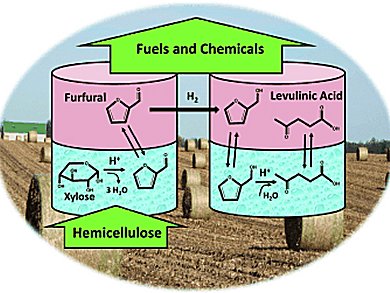The conversion of lignocellulosic biomass into fuels and chemicals requires effective utilization of the C5 and C6 sugars present in hemicellulose and cellulose, respectively, by either processing these fractions together or separating and processing them separately. Simultaneous processing, such as in gasification or pyrolysis, offers the potential for simplicity of operation. The fractionation of hemicellulose and cellulose allows the processing of each fraction to be tailored to take advantage of the different chemical and physical properties of these fractions, and provides increased flexibility of operation.
James A. Dumesic and colleagues, University of Wisconsin, Madison, USA, show that the hemicellulose fraction of lignocellulosic biomass can be converted into furfural and levulinic acid (FuAL and LA) by using biphasic reactors with alkylphenol solvents that selectively partition furanic compounds from acidic aqueous solutions. The biphasic systems consist of an extractive organic layer and an aqueous layer that contains a mineral acid. They achieve high concentrations of FuAL and LA, enabling the recovery of both products at the top of distillation columns, and eliminating issues related to deactivation and regeneration of solid acid catalysts.
The furfural and levulinic acid products are valuable compounds for a variety of chemical applications, and they serve as precursors for the synthesis of liquid transportation fuels.
Image: © Wiley-VCH
- Conversion of Hemicellulose to Furfural and Levulinic Acid using Biphasic Reactors with Alkylphenol Solvents,
Elif I. Gürbüz, Stephanie G. Wettstein, James A. Dumesic
ChemSusChem 2012.
DOI: 10.1002/cssc.201100608




